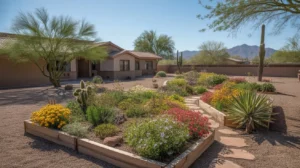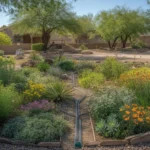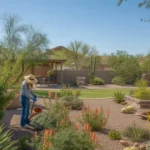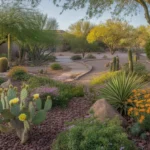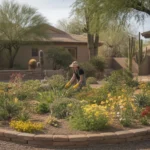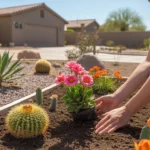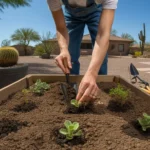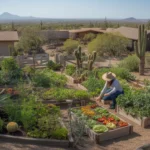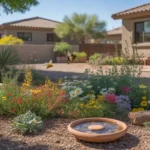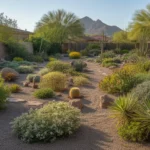Spring gardening in Chandler can be a tricky proposition. While the lengthening days and warming temperatures seem to beckon us outdoors, the challenges of tending a garden in the desert are just beginning to rear their heads. From unrelenting heat to voracious pests to soil that seems determined to defy our best efforts, spring gardening in Chandler is not for the faint of heart. But with a bit of know-how and a willingness to work with nature, you can create a thriving oasis that will be the envy of the neighborhood.
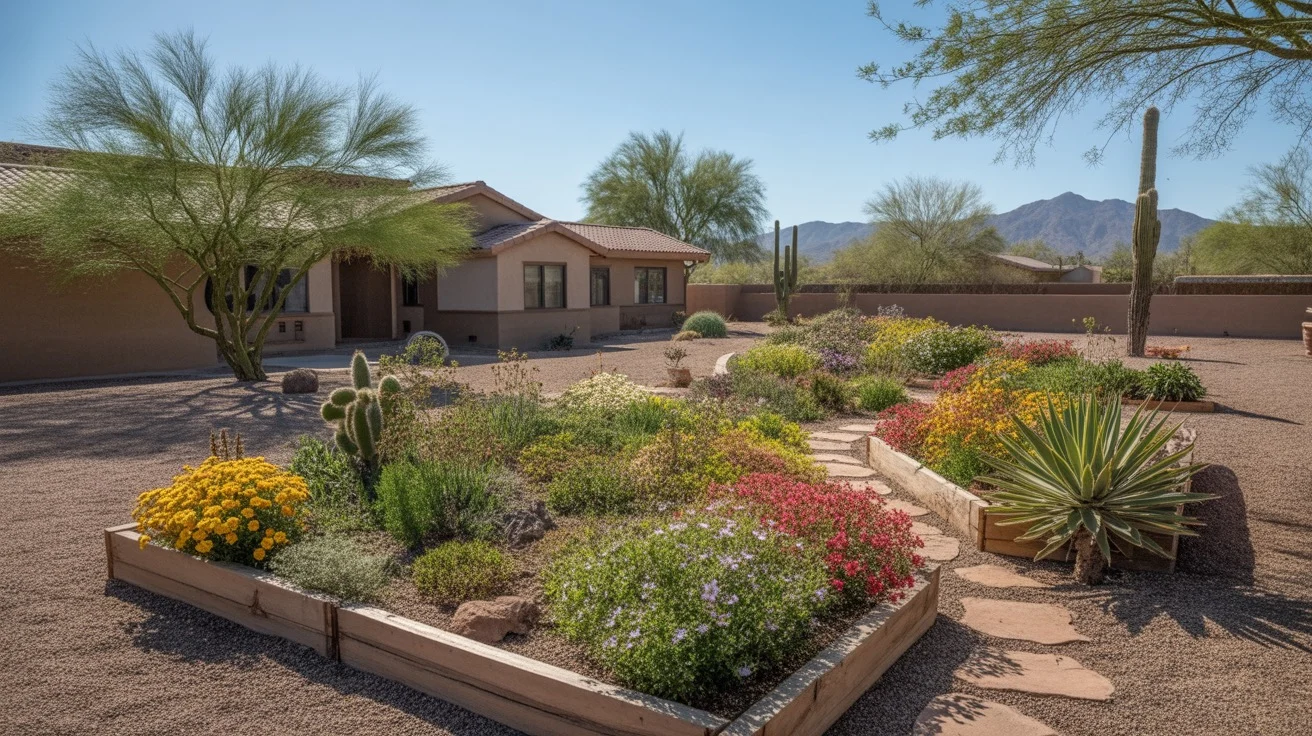
Combating Chandler’s Climbing Temperatures
🌡️ As any Chandler gardener knows, the heat is the biggest obstacle to a thriving spring garden. While temperatures in March and April can be delightful, by May the mercury is already climbing into the triple digits. This can spell disaster for tender young plants that are just getting established.
The key to success is to choose heat-tolerant varieties and to provide them with plenty of shade and water. Look for plants that are native to the Sonoran Desert or other hot, dry climates. These plants have evolved to withstand the punishing heat and will require less coddling to thrive. When planting, be sure to locate your garden in an area that receives some shade during the hottest part of the day. This could be on the east or north side of a building, or under the dappled shade of a tree.
Watering is also crucial. While it’s important not to overwater, which can lead to fungal diseases, you’ll need to provide consistent moisture to help your plants weather the heat. Water deeply and less frequently, aiming for the roots rather than the leaves. Mulching with a layer of organic matter can also help to retain moisture and regulate soil temperature.
Outsmarting Hungry Garden Pests
🐜 Another challenge of spring gardening in Chandler is dealing with the myriad pests that seem to appear out of nowhere as soon as the weather warms up. From aphids to whiteflies to the ever-present rabbits, it can feel like a constant battle to keep your plants from becoming someone else’s lunch.
One of the best ways to combat pests is to encourage their natural predators. Ladybugs, lacewings, and praying mantises are all voracious eaters of common garden pests. You can attract these beneficial insects by planting a diverse array of flowers and herbs, especially those in the umbel family like dill, fennel, and yarrow. Avoiding broad-spectrum pesticides will also help to preserve these helpful predators.
For larger pests like rabbits and javelinas, physical barriers may be necessary. A simple chicken wire fence around the perimeter of your garden can do wonders to deter these hungry herbivores. If you’re feeling crafty, you can also try your hand at making homemade repellents using ingredients like hot peppers, garlic, or predator urine (yes, you read that right).
Amending Chandler’s Challenging Soil
🪴 Chandler’s soil can be a gardener’s worst nightmare. Composed mostly of clay and caliche, it’s heavy, dense, and slow to drain. It’s also alkaline, which can make it difficult for plants to access the nutrients they need to thrive.
The solution is to amend, amend, amend. Before planting, work in generous amounts of compost, aged manure, or other organic matter. This will help to improve drainage, aeration, and fertility. You may also want to consider raised beds or container gardening, which allows you to control the soil mix more precisely.
When it comes to fertilizing, opt for a slow-release, organic fertilizer rather than a quick-acting synthetic one. This will provide a steady supply of nutrients over time, rather than a sudden jolt that can burn delicate roots. You may also want to consider adding sulfur or other acidifying agents to help lower the pH of the soil.
Choosing the Right Plants for Chandler’s Climate
🌵 Of course, one of the best ways to set yourself up for success is to choose plants that are well-suited to Chandler’s unique climate and growing conditions. While it can be tempting to try to grow the same plants that thrive in other parts of the country, the reality is that many of them simply won’t make it in the desert.
Instead, focus on native and adapted plants that have proven themselves in the Sonoran Desert. Cacti and succulents are obvious choices, but there are also many beautiful perennials, shrubs, and trees that can add color and interest to your landscape. Some great options include:
- Desert marigold (Baileya multiradiata)
- Fairy duster (Calliandra eriophylla)
- Texas sage (Leucophyllum frutescens)
- Palo verde (Parkinsonia spp.)
- Ironwood (Olneya tesota)
By choosing plants that are adapted to Chandler’s climate, you’ll not only save yourself a lot of frustration, but you’ll also create a landscape that is more sustainable and requires less maintenance in the long run.
Embracing Chandler’s Unique Growing Season
🌞 Finally, it’s important to remember that Chandler’s growing season is a bit different than what you might be used to if you’re from other parts of the country. While the rest of the nation is just starting to think about planting their tomatoes and peppers, Chandler gardeners are already harvesting their spring crops and preparing for the long, hot summer ahead.
Embrace this unique growing season by planting early and often. Many cool-season crops like lettuce, peas, and brassicas can be planted as early as January or February, giving you a jump start on the growing season. As the weather warms up, transition to heat-loving crops like eggplant, okra, and black-eyed peas.
And don’t forget about the fall garden! While the rest of the country is winding down, Chandler gardeners are gearing up for a second planting of cool-season crops. With a little bit of planning and some strategic planting, you can enjoy fresh vegetables from your garden almost year-round.
Seeking Out Local Wisdom and Resources
🧑🌾 Gardening in Chandler can be a challenge, but you don’t have to go it alone. There are many local resources available to help you succeed, from master gardener programs to community gardens to local nurseries and garden centers.
One of the best ways to tap into this local wisdom is to join a gardening club or attend a workshop or seminar. The Maricopa County Master Gardeners offer a wealth of classes and events throughout the year, covering everything from desert landscaping to vegetable gardening to composting and soil health.
You can also seek out advice from experienced gardeners in your neighborhood or community. Don’t be afraid to ask questions or seek out mentorship from those who have been successfully gardening in Chandler for years. They can offer invaluable insights and tips that you won’t find in any book or website.
Celebrating Your Chandler Spring Garden Successes
🌻 Gardening in Chandler may be challenging, but it’s also incredibly rewarding. There’s nothing quite like the satisfaction of biting into a sun-ripened tomato or admiring a vibrant bed of wildflowers that you grew with your own two hands.
So don’t be discouraged by the challenges of spring gardening in Chandler. With a little bit of knowledge, a lot of patience, and a willingness to work with nature, you can create a beautiful and bountiful garden that will be the envy of the neighborhood. And who knows? You might just inspire others to take up the trowel and join you in the joyful, rewarding work of growing something beautiful in the desert.

